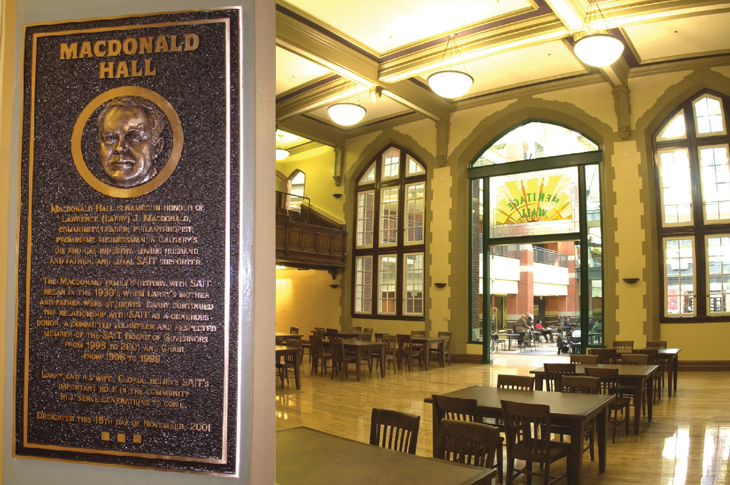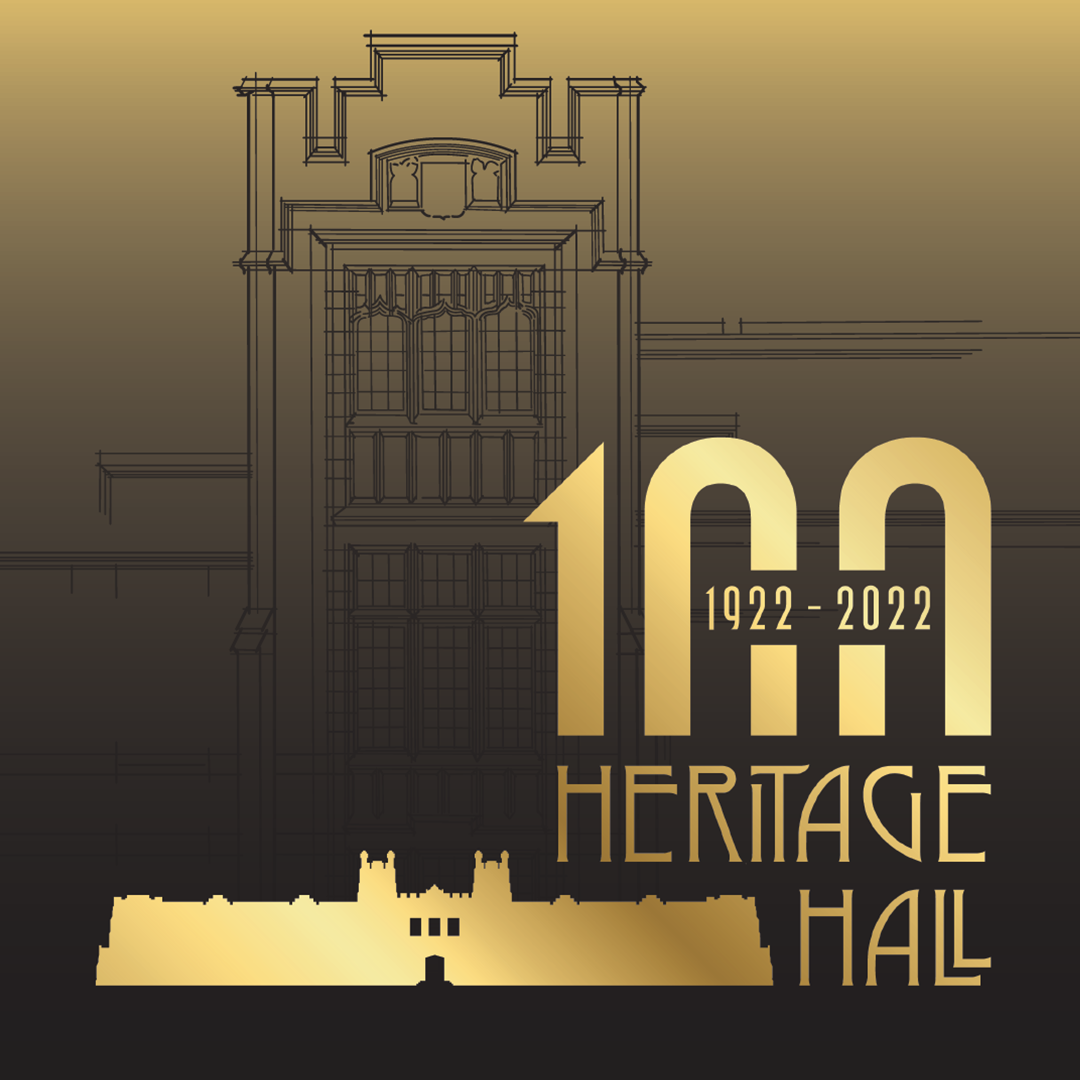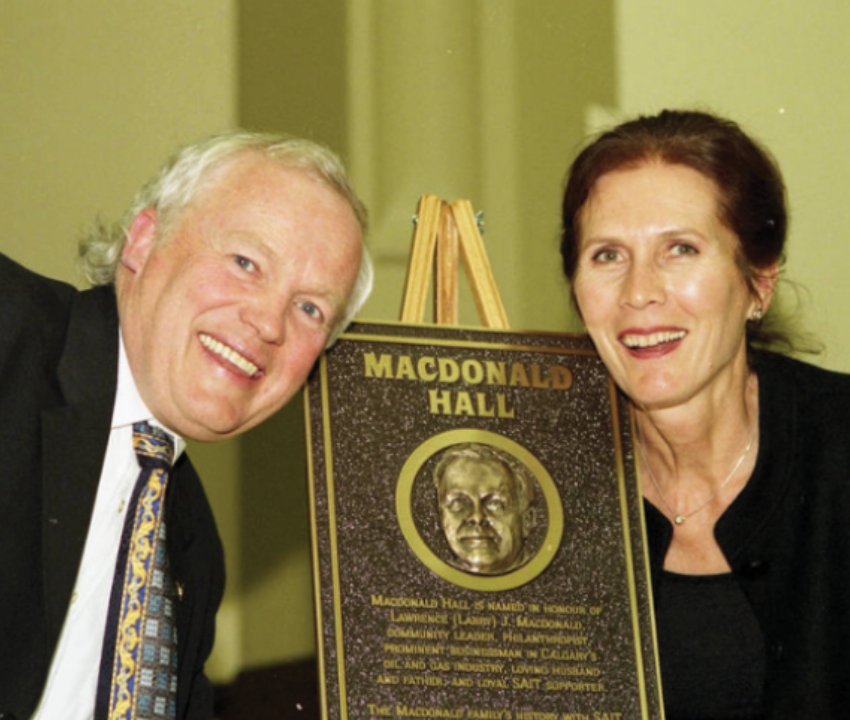About the episode

Heritage Hall is one of the most identifiable buildings in Calgary — and the embodiment of SAIT’s history as a global leader in applied education. This episode explores the vital role volunteering, generosity and giving back have played in establishing Calgary as a world-class city, and in elevating SAIT as an institution. From the excitement of the 1988 Winter Olympics to corporate gifts to serving on the SAIT Board of Governors, philanthropy has transformed SAIT in countless ways.
Join Brian Bowman, Director of Alumni and Development at SAIT, and Larry Macdonald, a strong supporter who has served SAIT in many ways (including as Chair of the Board of Governors) and who received an honorary SAIT Bachelor of Technology degree in 2006, as they discuss the ways philanthropy nurtures great cities, the excitement of restoring Heritage Hall during the 1980s and how giving back enables students to succeed today and in the future.
Photo: A photo of the plaque made to commemorate the naming (left) and an interior photograph of Macdonald Hall (right).
(Intro) DR. DAVID ROSS: What is possible with a steadfast and bold vision. Welcome, welcome to SAIT!
(0:15) FEMALE VOICE OVER: A red brick and sandstone building looms large on Calgary's north hill, complete with twin towers, Gothic arches, and gargoyles. They've stood watch over the city for a hundred years. Now, this is Heritage Hall, the heart of the Southern Alberta Institute of Technology known as SAIT and we are celebrating the lessons of the past 100 hundred years since students first walked through its doors. One hundred years of innovation, pushing boundaries and leading by example. One hundred years of getting SAIT students up to speed for a rapidly changing new world. Join us and learn from the stories whispered from these walls celebrating 100 years of Heritage Hall. What lessons would we learn if only these halls could talk?
(1:12) RON TARRANT: William Shakespeare wrote. “What’s in a name…” And no, this isn’t like Romeo and Juliet blood feuds. Yeah, we ain’t about that life. We don’t want that smoke, but what about love? Love has played a major role in the story of Heritage Hall. Love for community love, for legacy love for philanthropy, love for Heritage Hall. So, what is in a name? Everything! Heritage Hall couldn’t have evolved into what SAIT is today without our donors. And that’s why you see their names everywhere in Heritage Hall and across campus. It’s the names behind those who’ve given back to help propel students’, industry and the institution forward, and also a way to cement their family’s legacy, sometimes literally in a brick and mortar. It’s these generous gifts that create ripple effects within the community — gifts that help create the future of entrepreneurs, business professionals, and talented workforce who innovate, inspire, and pass the torch onto the next wave of students and donors. It kind of gives a whole new meaning to the circle of life. After all it’s Heritage Hall, it’s SAIT and it will continue to live up to the name because of the names who support it.
(2:23) BRIAN BOWMAN: My name is Brian Bowman. I’m the director of Alumni and Development at SAIT, and I have been in my role supporting the alumni relations effort and the fund development effort on our SAIT campus for the past 14 years. Heritage Hall has existed on that campus for a long time and what occurs to me in talking with alumni, former students, but beyond to other Calgarians who don’t know SAIT as well as our alumni do, or as I do. And how beloved that building is, how well known it is. And it sits there up on the hill and many people comment, “Oh, that gorgeous old building, it’s one of the most identifiable buildings in all of Calgary”. And so, what it means to me in many respects is about this notion of history. That is an important part of the SAIT campus. But when we contemplated the new structures that were going to comprise the Trades and Technology complex, the pointed departure for the architects was Heritage Hall.
It had a rhythm, it had texture, it had architectural elements that became thematic and that were repeated across the campus. It is the anchor of the campus. It’s the center of everything that happens there. So, as a citizen of Calgary and somebody who is engaged at a civic level, I look around our city at many of our institutions and cultural organizations and I can say we are a world-class city because of the generosity and philanthropic support that we have seen.
You know, philanthropy is defined as the love of mankind. And then when we think about its implementation in so many different areas of life in Calgary and what makes Calgary a great city, we move beyond just being a good city with, you know, basic amenities to being a great city and a place that I think we’re proud to be part of. And philanthropy is the avenue by which people express their passion, in which they demonstrate gratitude, in which they elevate the organizations around us to be better than they would be otherwise. Philanthropy at SAIT really carries a different kind of weight in that is about the stories that we can tell of the institution and the success that we’ve had, both in regard to corporate relations and the many alumni who have graduated and gone on to very successful careers in lives. Because philanthropy is a way of giving back and elevating the institution for the benefit of the future students, the students that are there today, the students that will be there tomorrow.
So, if you look around the campus, you see buildings that are named after prominent alumni, you see corporate representation and state-of-the-art technology that is in use as part of the educational curriculum. Philanthropy is what has taken SAIT from being just an okay and respectable technology Institute – to one that is the envy of anywhere in the world with world-class facilities, world-class institutions, world-class instruction. And one thing leads to another that begets more individuals who want to be part of SAIT, to give back, to get their education there, whatever the case may be. But beyond that, too, I think if you even look back to 1988, the Winter Olympics, there was a beginning there of a real volunteer spirit. Those factors, the idea, volunteering and civic engagement and the duty of responsibility that individuals play to create a great city that is manifested in the body and in the man that is Larry Macdonald. And when I think about those individuals around who have, we can trace back the culture that we have created in this great city, Larry Macdonald is one of those and continues to be a legend. <background voice echoing, “Continues to be a legend”>.
(6:07) LARRY MACDONALD: My name is Larry Macdonald and I was born and raised in the Okotoks area. And my grandmother had a house in Rosedale. So, several blocks from SAIT, in fact, that was almost the edge of the city at that at that time. And my brother and I would take a ball and go over to the SAIT grounds and kick the ball around. And there was, the trees were tiny and I’ve driven up there in the last several months. And those trees are massive now. So, it’s, SAIT has really grown up. The trees are grown up and the buildings are up. When I went on the board, Heritage Hall was a bit of a problem. It needed a lot of work and we really didn’t have the money to do the work. So, what are we gonna do with Heritage Hall?
And so finally we raised the money, borrowed the money to redo Heritage Hall. And we started into what is now Macdonald Hall and it all up areas all covered in plywood. And it was just an ordinary room seemed like, but when they removed the plywood, there was this wonderful woodwork, the balconies, and it was just a stage. And it’s just a wonderful, wonderful room. So, I had probably spent, well, I measured at one time, I spent years volunteering for SAIT. And when Irene Lewis came along, she asked me if I wanted the hall named after Macdonald’s. And I at first said, no, I mean, we don’t need recognition for what we do, but after she asked me the second time, I said, sure, that’d be great. So, when I’m driving down the road on a Sunday afternoon and someone says they had a wedding at Macdonald Hall, it makes me feel kind of warm inside.
Both my wife and I sort of think we are country bumpkins. You know, we were very lucky. We were able to get an education in Alberta, went to university, didn’t have a lot of money, but we were able to get grants and scholarships. So, we feel very lucky that both of us got degrees. I got a degree in science and my wife has a teaching degree from the University of Alberta. And we feel very lucky and it’s kind of a cliché, but we feel that it’s, it’s our obligation to give something back. Today, a SAIT education is wonderful. I mean, you’ll, you’ll probably get a job right away and a job in the field that you’re trained in. And so, I think SAIT is just a tremendous institution. The classes are small. The instructors kind of keep an eye on you and make sure you’re attending. I think SAIT is just awesome and SAIT, it’s very important to Calgary. I think it’s just an awesome institution.
(8:35) BRIAN BOWMAN: So, a number of spaces inside of Heritage Hall bear the names of individuals. And as I say, you know, if you walk around our campus, the stories behind the namings and so on, not all of them are philanthropic. Some of them are honorific, as in the case of Senator Burns and things of that sort. But up on the third floor of Heritage Hall, outside of the magnificent SMED boardroom, is the Richardson Foyer, and Deanna and Wes Richardson wanted to do something for the institution. And we wanted a naming space that was somewhat generic. So, it wasn’t attached to any specific school, but Deanna and Wes, as well as Wes’ mother Ruth, wanted to make a lasting gift. This is what we would call a big bequest. So, something that is invested and contributes over the course of time through interest income. This gorgeous space up on the third floor, outside of the executive offices and again, outside of the SMED boardroom, sits with this gorgeous spiral staircase that goes up to the princess towers, we call it, the fourth floor and the lookout over south Calgary. And there sit the two chairs that we pull out for convocation ceremonies and the mace that we use in convocation ceremonies.
As you look at spaces in Heritage Hall, the third-floor houses, the SMED boardroom named of course for the company and through their generosity, there’s a beautiful large boardroom table that is in that space. And an example of corporate Calgary’s support for SAIT, our initiatives and priorities. And at that table boards have met, management council has met, Dean’s council has met, we’ve had events inside of that space. And over the course of time, it’s been the center of many decisions that have been made, many meetings, really the leadership of the institution. It’s an example, too, of how corporate Calgary has played a significant role in moving SAIT from good to great. It is 20 years ago that SMED, through a generous gift-in-kind outfitted that space with some of their own furnishings. And one of many examples where corporate Calgary has extended its generosity to our students, our faculty, and our staff through gifts in kind and their generous philanthropic support.
(10:52) RON TARRANT: Continue the journey through SAIT's historical past visit sait.ca/alumni for more episodes.
Listen now

Celebrating 100 years of history
To commemorate the first 100 years of the iconic Heritage Hall building, we released an intriguing eight-episode audio series and dedicated the Spring 2022 issue of LINK magazine that share the memories and stories from SAIT alumni, employees and neighbours.

Oki, Âba wathtech, Danit'ada, Tawnshi, Hello.
SAIT is located on the traditional territories of the Niitsitapi (Blackfoot) and the people of Treaty 7 which includes the Siksika, the Piikani, the Kainai, the Tsuut’ina and the Îyârhe Nakoda of Bearspaw, Chiniki and Goodstoney.
We are situated in an area the Blackfoot tribes traditionally called Moh’kinsstis, where the Bow River meets the Elbow River. We now call it the city of Calgary, which is also home to the Métis Nation of Alberta.
